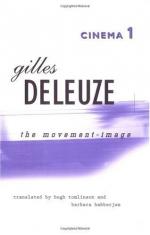|
This section contains 672 words (approx. 2 pages at 400 words per page) |

|
Theses on movement, First commentary on Bergson Summary and Analysis
In his first book about film Gilles Deleuze writes about the traditional meaning of the word "philosophy" as "the creation of concepts." This book titled "Cinema 1" is published in 1983, in which he proposes, ". . . it is not sufficient to compare the great directors of the cinema with painters, architects or even musicians. They must also be compared with thinkers. . . . that the future makes possible."
Bergson's first thesis of movement and instant is one of his three theses on movement in film. This thesis posits that movement is distinct, or apart from space covered. However, the underlying notion shows that movement is not separate from space but occurs in the interval between spaces. Bergson calls this "cinematographic illusion." Cinema offers false movement. For example, a series of snapshots viewed in sequence...
(read more from the Theses on movement, First commentary on Bergson Summary)
|
This section contains 672 words (approx. 2 pages at 400 words per page) |

|




